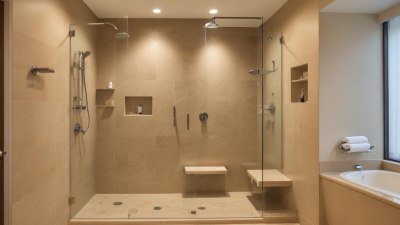Why Hotel Shower Controls Feel More Complicated Than Rocket Science
Explore the perplexing design of hotel shower controls and why they often seem so complicated.

Image created with Flux Schnell
The experience of staying in a hotel is often tied to relaxation, comfort, and indulgence. However, one aspect of hotel life that often perplexes guests is the shower controls. It’s the ordinary act of taking a shower that can turn into a confusing puzzle with knobs, levers, and buttons that seem to defy all logic. How did something as simple as turning on the water become a situation that feels more complicated than rocket science? In this article, we will dissect the reasons behind the complexity of hotel shower controls.
The History of Shower Design
The evolution of shower design can be traced back to ancient civilizations, where simple water source manipulation provided bathing facilities. As plumbing technology advanced, so did shower systems. By the time hotels began to emerge as establishments of hospitality, the need for efficient and effective shower systems increased. The push for luxury in hotels led to unique designs that prioritized aesthetics over functionality. These evolving designs laid the groundwork for the intricate systems we encounter in hotels today.
Types of Shower Controls
Hotel showers can have a variety of control types, and this diversity contributes to the confusion faced by guests. Some hotels might use the traditional knob system where hot and cold water is controlled through manual knobs. Others might deploy a digital interface that requires guests to navigate a menu-driven screen to adjust water temperature and flow. Another common type is the thermostatic control system that can feature a single lever but may require specific actions to achieve the desired temperature. The disparity in controls from one hotel to another can create confusion, especially when guests have just a brief time to figure them out before wanting to enjoy their shower.
Design for Aesthetics vs. Usability
One of the primary reasons hotel shower controls are often complicated is the design prioritization seen in many hotels. Many high-end hotels opt for sleek, modern architecture that favors minimalist aesthetics. Designers may choose to use controls that look attractive but compromise usability. The juxtaposition between form and function can leave guests fumbling with controls that require more precision and understanding than they are prepared for. A beautiful design may garner compliments but fall short when it comes to actual use, making it feel frustrating and overly complex.
Guest Variability
The demographic diversity of hotel guests means that not everyone is well-versed in modern shower technology. Consider a family on vacation who might be used to a standard household shower versus a business traveler who frequently stays at different hotels. The variability extends to age as well, with older guests possibly finding digital controls particularly challenging. This diversity indicates that only a universal design approach can effectively simplify shower controls. Unfortunately, achieving such universality is complicated by the desire for hotels to stand out through their design choices.
The Digital Dilemma
With advances in technology, many hotel showers now incorporate smart features. The concept of a smart shower may seem appealing, but for guests who are unfamiliar with such technology, it can become overwhelming. Guests may struggle with touch-sensitive controls, voice-activated systems, or programmable settings. The lack of standardization means even technologically-savvy guests may feel intimidated when placed in an unfamiliar environment, struggling to remember the exact steps to take a simple shower.
Signs and Instructions
While many hotels do provide instructions on how to use shower controls — whether through signage or printed materials — the effectiveness of these guides varies widely. Often, the provided instructions are a bit too technical or assume prior knowledge that the average guest does not possess. In many cases, guests find themselves looking for signage only after they’ve struggled to turn on the water, potentially leading to water wastage and frustration. This barrier between understanding the system and operating it effectively can transform a straightforward shower experience into one that feels unnecessarily complex.
Poor Functionality
Another factor contributing to the complexity of hotel shower controls can be their functionality. Poorly designed systems may create situations where what should be a simple process — like getting hot water — becomes a convoluted struggle. Issues like fluctuating water pressure, improperly set thermostatic valves, or even malfunctioning units add to the level of discomfort that guests may feel with the shower systems. In these cases, the complexity isn’t just about the controls but also about how they actually work, or rather don’t work, leading to further confusion about how to get things right.
Environmental Considerations
In recent years, many hotels have made strides toward environmental sustainability. This can manifest as water-saving showerheads or dual-flow systems meant to conserve water. While these innovations are commendable, they often complicate the controls and may limit the variety of options available to guests. Fewer options for water flow or temperature can make achieving the perfect shower more difficult than ever, contributing to feelings of frustration when trying to navigate the unfamiliar system.
Consistency Across Properties
One persistent issue within hotel chains is the lack of consistent design across different properties. A global hotel brand may have several locations that feature various types of shower systems tailored to the specific design and architecture of each site. Guests who travel frequently often find themselves confused when they check into a new hotel, unsure of how the shower controls will function. Standardization could greatly improve the guest experience, but it’s complicated by the need for hotels to maintain unique identities within their design and offerings.
Training and Staff Awareness
Another layer to the complexity of hotel shower controls lies in staff training. In many properties, hotel staff may not even be fully trained on how to operate each and every system present throughout the property. When guests encounter difficulties, they often turn to the front desk or housekeeping for assistance. However, if the staff is unfamiliar with a particular system, they may be unable to offer effective troubleshooting tips or assistance, compounding the issue guests face while trying to find relief in the shower. Hotels can benefit from investing in staff training to better equip them with the knowledge needed to assist guests.
The Impact of Reviews and Customer Feedback
In the age of online reviews, customer feedback can greatly impact how hotels approach their design and amenities. A few disappointed guests who struggle with shower controls can leave significant marks on review platforms, influencing the decisions of future visitors. As hotels want to cater to customer preferences, they might begin to change and trial new systems. These shifts can lead to even more variance in shower controls as hotels try to find the perfect balance between aesthetics, usability, and guest satisfaction. Such changes may lead to a never-ending cycle of confusion for guests who have to adapt to each hotel’s evolving systems.
Conclusions: Finding Solutions
At the heart of the hotel shower control conundrum is a quest for balance. Hotels must weigh the need for attractive designs with the necessity for intuitive functionality. Educating guests on the systems available can help mitigate confusion, and investing in universal design principles will foster a more pleasant guest experience. Perhaps the true challenge will be to unify shower control systems in a way that welcomes all guests, regardless of their backgrounds or familiarity with modern technology. Until then, taking a shower in a hotel will remain a complicated affair, often evoking the same level of challenge and complexity as rocket science.











